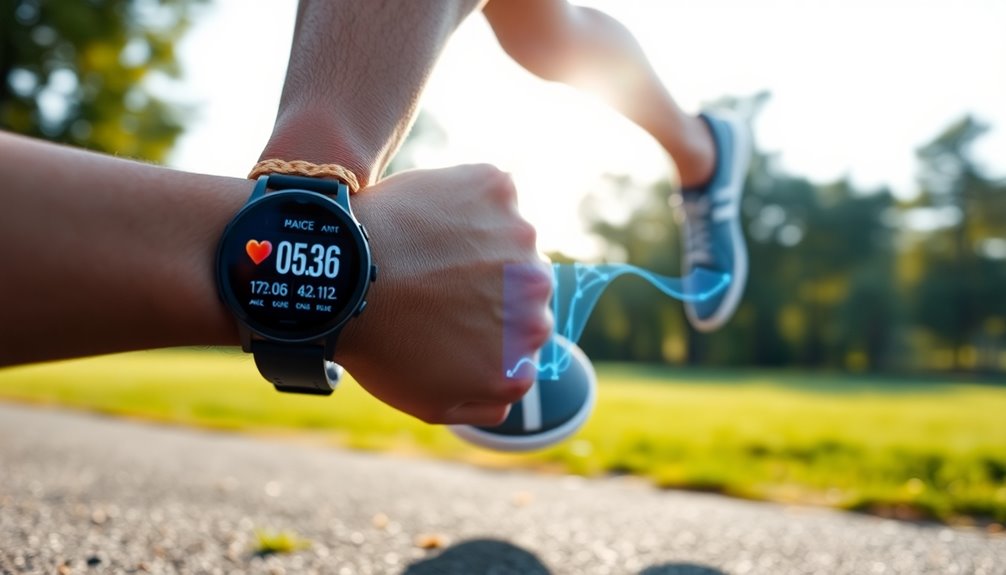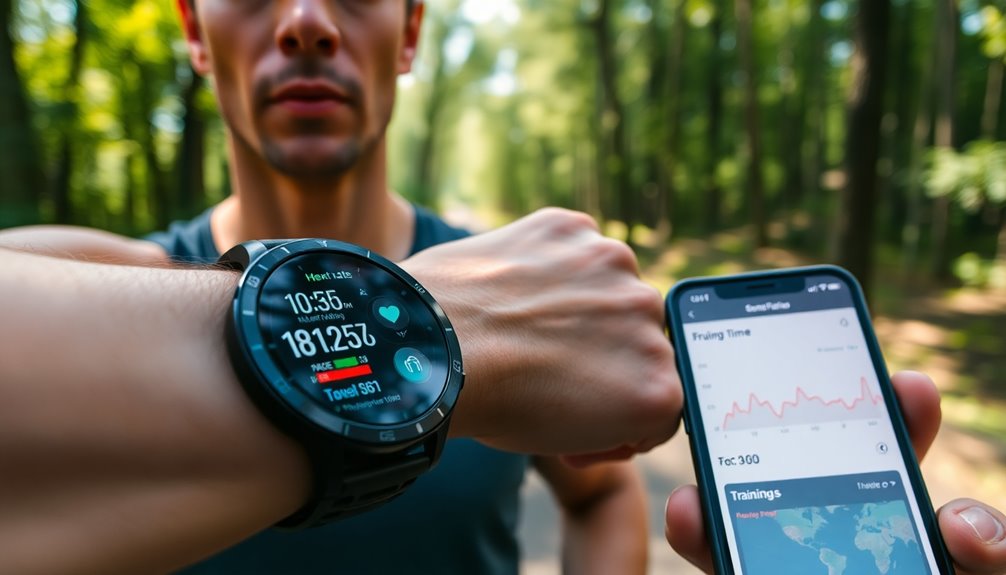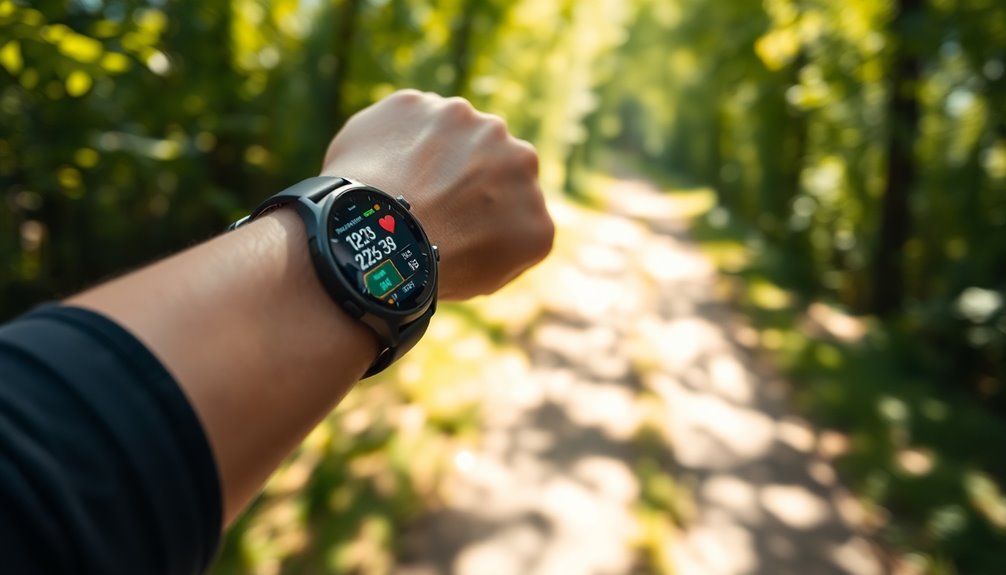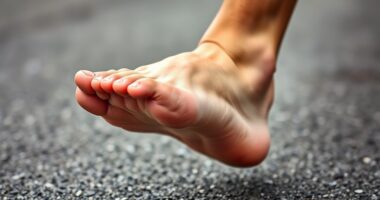Wearable technology is revolutionizing your running experience by providing real-time metrics that boost performance and minimize injury risks. Key metrics like heart rate, cadence, and ground reaction force help you fine-tune your training. With insights into your biomechanics, you can adjust your regimen to prevent injuries. Accurate data is vital for effective tracking, making it essential to choose the right device. Stick around to discover more ways tech can elevate your running journey.
Key Takeaways
- Wearable devices like fitness trackers and smartwatches provide real-time monitoring of heart rate, distance, and pace, enhancing training efficiency.
- Key metrics such as cadence, stride length, and ground reaction force help improve running form and prevent injuries.
- Advanced wearables analyze biomechanics, tracking pronation and pelvic angles to identify potential movement dysfunctions.
- Data accuracy is crucial; wrist-based heart rate monitors may be less reliable than chest straps for precise performance tracking.
- Continuous monitoring and analysis of metrics can lead to proactive adjustments in training, reducing injury risks during running.
The Role of Wearable Technology in Running

As you lace up your running shoes, wearable technology plays an essential role in enhancing your performance and training experience.
Wearable devices like fitness trackers and smartwatches help you monitor key metrics, including heart rate, distance, and pace. With real-time data from heart rate monitors, you can adjust your intensity, ensuring you're training effectively.
Advanced wearables use sensors to provide insights into your biomechanics, helping prevent injuries and optimize performance. GPS integration allows you to track your routes accurately, analyzing speed and elevation changes for better training efficiency.
By leveraging this technology, you gain valuable insights into your recovery and sleep quality, which are vital for maximizing your athletic potential.
Embrace these tools to elevate your running journey.
Key Metrics for Runners: What to Track

While tracking your running progress, understanding key metrics can greatly enhance your performance. Start by monitoring your heart rate using wearable technology; this helps you gauge training intensity and guarantees you’re working within ideal heart rate zones. In addition to heart rate monitoring, keeping track of your pace and distance can provide valuable insights into your endurance and efficiency. Incorporating time management strategies for athletes is also essential, as it allows you to allocate specific training periods and recovery times effectively. By balancing your workouts with rest and other commitments, you can optimize your performance and ensure consistent progress toward your running goals.
Next, pay attention to spatio-temporal metrics like cadence and stride length, which provide insights into your running efficiency. Additionally, consider ground reaction force (GRF) to assess impact forces and identify potential injury risks, such as excessive pronation linked to plantar fasciitis.
Tracking caloric expenditure is vital for managing energy balance, aligning your nutrition with your training goals. Finally, keep an eye on kinematic metrics like pelvic angles to spot movement dysfunctions that could lead to injuries.
Understanding Biomechanics Through Wearables

How can wearables revolutionize your understanding of running biomechanics? With wearable technology, you can track critical metrics like ground reaction force, pronation, and pelvic angles in real-time. This data not only enhances your training programs but also helps pinpoint injury risks, such as plantar fasciitis and shin splints. By monitoring these biomechanics, you can make timely adjustments to your regimen, preventing injuries before they occur.
| Metric | Importance | Impact on Performance |
|---|---|---|
| Ground Reaction Force | Identifies impact forces | Reduces injury risk |
| Pronation | Assesses foot alignment | Improves running efficiency |
| Pelvic Angles | Links to knee and lower leg pain | Enhances overall form |
Embrace this technology to stay ahead of your running game!
The Importance of Data Accuracy in Performance Tracking

Wearable technology can provide invaluable insights into your running biomechanics, but the effectiveness of these tools largely hinges on data accuracy.
If you're using wrist-based heart rate monitors, you might find them less reliable than chest straps, which can impact your training decisions. The photosensor technology in wearables can give variable results, making it vital to analyze trends over time rather than focusing on single readings.
Metrics like ground reaction force and power output need precise measurement to inform your training and recovery strategies effectively.
In addition, regularly validating your wearable technology's accuracy, especially during high-speed activities, is essential for ensuring the data you rely on truly influences your coaching and performance outcomes.
Utilizing Wearables for Injury Prevention

As you lace up your running shoes, consider how integrating wearable technology into your routine can greatly reduce your risk of injury.
Devices like IMUs and pressure-sensing insoles track critical metrics such as ground reaction force and pronation. By monitoring excessive pronation, you can identify potential risks for injuries like plantar fasciitis and shin splints, allowing for timely intervention.
Advanced wearables provide real-time insights into your biomechanics, helping you and your coach adjust training regimens proactively. Continuous data collection reveals movement patterns, guiding informed decisions about mobility and strength exercises focused on injury prevention.
Analyzing metrics like pelvic angles and power output deepens your understanding of how biomechanics relate to common running injuries, enhancing your overall training safety.
Analyzing Training Stress and Recovery Metrics

Tracking your training stress and recovery metrics can enhance your performance and minimize injury risk. One key metric is heart rate variability (HRV), which indicates your body's recovery status. Higher HRV usually means you're recovering well and ready for more intense workouts.
Additionally, monitoring your training load through session ratings of perceived exertion (RPE) helps you understand cumulative stress, allowing for better training adjustments. Don't forget about sleep quality; prioritizing rest improves performance and reduces injury risk.
Wearables can also track ground reaction forces (GRF), offering insights into your running mechanics. Over time, analyzing these data trends helps you optimize your training regimen, striking the right balance between pushing your limits and ensuring adequate recovery.
The Future of Wearable Tech in Running

While the running landscape continues to evolve, the future of wearable tech promises to revolutionize how you train and interact with your performance metrics.
With innovations on the horizon, you can expect:
- Enhanced biometric sensors delivering accurate data for better insights.
- Immersive virtual and augmented reality experiences to simulate diverse running conditions.
- AI-driven coaching systems that personalize your training program in real time.
- Advanced health insights, including early injury detection based on biomechanics.
As wearable technology continues to advance, it aims to improve usability, making it easier for runners of all levels to access valuable information.
This evolution not only motivates you to push your limits but also guarantees you're training smarter, not just harder.
Choosing the Right Wearable Device for Your Needs

How do you choose the right wearable device for your running needs? Start by considering the specific metrics that matter to you, like heart rate, GPS distance, and recovery data.
Fitness trackers like Oura and Whoop provide extensive health monitoring, while Stryd focuses on running-specific metrics such as power output and gait analysis.
Look for wearables with long battery life to support all-day tracking and long workouts—this is vital for consistent use. Comfort is key; an ergonomic design will encourage regular wear during training.
Finally, familiarize yourself with the device's app interface so you can effectively interpret the data. This will help you turn metrics into actionable insights, enhancing your running performance through informed training decisions.
Balancing Data Usage With Intuitive Training

Integrating wearable technology into your running routine can enhance your performance, but it's important to balance data usage with your body's natural signals. Relying solely on metrics can lead to overtraining or burnout.
To maintain this balance, consider these tips:
- Listen to your body's signals; they often reveal more than data.
- Set specific, achievable goals using historical data to stay motivated.
- Regularly review your metrics while reflecting on how you feel during runs.
- Use data as a tool, not a crutch; combine it with established training principles.
Frequently Asked Questions
What Are the 4 Wearable Technologies?
You've got four main types of wearable technologies to evaluate.
First, fitness trackers like Fitbit monitor your heart rate and activity levels.
Next, smartwatches combine fitness tracking with smartphone features, giving you GPS and notifications.
Then, heart rate monitors, available as chest straps or wrist devices, measure your heart rate during exercise.
Finally, power meters help you gauge your running power output, optimizing your training by revealing the energy cost of your efforts.
What Is Wearable Technology in Running?
You might think running's just about putting one foot in front of the other, but wearable technology says otherwise.
It's revolutionizing how you track your performance. With fitness trackers and smartwatches, you monitor heart rate, pace, and distance effortlessly. Advanced sensors even analyze your running form!
Thanks to GPS, you can map your routes. Soon, AI will coach you, adapting training plans based on your real-time data.
Who knew running could be this high-tech?
What Do You Understand About Wearable Technology?
Wearable technology's transformed how you track your fitness.
These devices, like fitness trackers and smartwatches, help you monitor heart rate, calories burned, and even sleep patterns. You can gather data on your performance, identify strengths and weaknesses, and set personalized goals.
However, keep in mind that not all devices are equally accurate, especially wrist-based monitors compared to chest straps.
Embracing this technology can greatly enhance your training and overall health journey.
What Technology Is Used for Running?
Imagine you're on a run, every step feeling lighter, but how do you know if you're really improving? That's where technology comes in.
You've got wearables like fitness trackers and smartwatches that monitor your heart rate and pace. There are specialized sensors too, tracking your footstrike patterns and biomechanics.
GPS helps you measure distance and route, giving you instant feedback to enhance your performance. With this tech, you're not just running; you're optimizing every stride.
Conclusion
As you lace up your shoes and hit the pavement, remember that the right wearable tech can be your modern-day compass, guiding you through the labyrinth of training. By tracking key metrics and understanding your body's signals, you're not just running; you're starting a journey of self-discovery. Embrace the data, but don't forget to listen to your instincts—like a seasoned explorer, balance the maps with the thrill of the open road ahead.









